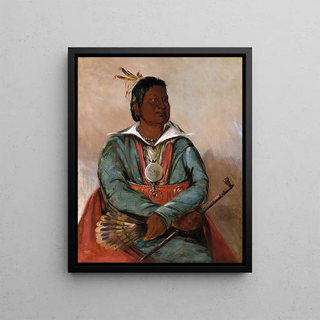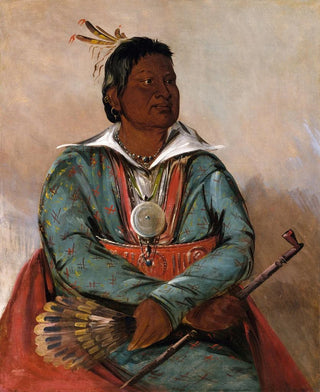Art print Msholatbbee The one who extinguishes and kills the tribe chief - George Catlin


View from behind

Frame (optional)
George Catlin’s artwork "Msholatbbee Celui qui éteint et tue le chef de la tribu" is much more than a simple painting; it is an entry point into a fascinating world—the cultures of Native Americans in the 19th century. As an artist and ethnographer, Catlin captured the very essence of the peoples he encountered during his journeys across North America. This art print invites us to immerse ourselves in an era when the traditions and rituals of Indian tribes were not only celebrated but also threatened by colonial expansion. Contemplating this piece transports the viewer to the heart of a rich visual narrative, where each brushstroke tells a story of struggle, pride, and resilience.
Style and uniqueness of the artwork
The uniqueness of this piece lies in its distinctive style, blending realism and romanticism. Catlin used vivid colors and dynamic compositions to pay homage to the majesty of the figures he depicted. In "Msholatbbee," he portrays a tribal chief with an intensity that captures attention, every detail of his face and traditional costume reflecting a deep admiration for his culture. The posture of the character, both powerful and vulnerable, evokes a duality at the core of the human experience. By incorporating symbolic and narrative elements, Catlin manages to transcend mere pictorial representation, creating a work that resonates with universal themes of power and sacrifice. This approach gives the piece emotional depth that continues to move contemporary viewers.
The artist and his influence
George Catlin, often regarded as one of the pioneers of American art, dedicated his life to documenting Native American cultures at a time when they were in peril. His commitment goes far beyond art; it represents a conscious effort to preserve the traditions and stories of often marginalized peoples. Traveling across the United States, he met numerous tribes, immersing himself in their ways of life, their beliefs

Matte finish

View from behind

Frame (optional)
George Catlin’s artwork "Msholatbbee Celui qui éteint et tue le chef de la tribu" is much more than a simple painting; it is an entry point into a fascinating world—the cultures of Native Americans in the 19th century. As an artist and ethnographer, Catlin captured the very essence of the peoples he encountered during his journeys across North America. This art print invites us to immerse ourselves in an era when the traditions and rituals of Indian tribes were not only celebrated but also threatened by colonial expansion. Contemplating this piece transports the viewer to the heart of a rich visual narrative, where each brushstroke tells a story of struggle, pride, and resilience.
Style and uniqueness of the artwork
The uniqueness of this piece lies in its distinctive style, blending realism and romanticism. Catlin used vivid colors and dynamic compositions to pay homage to the majesty of the figures he depicted. In "Msholatbbee," he portrays a tribal chief with an intensity that captures attention, every detail of his face and traditional costume reflecting a deep admiration for his culture. The posture of the character, both powerful and vulnerable, evokes a duality at the core of the human experience. By incorporating symbolic and narrative elements, Catlin manages to transcend mere pictorial representation, creating a work that resonates with universal themes of power and sacrifice. This approach gives the piece emotional depth that continues to move contemporary viewers.
The artist and his influence
George Catlin, often regarded as one of the pioneers of American art, dedicated his life to documenting Native American cultures at a time when they were in peril. His commitment goes far beyond art; it represents a conscious effort to preserve the traditions and stories of often marginalized peoples. Traveling across the United States, he met numerous tribes, immersing himself in their ways of life, their beliefs
12,34 €






